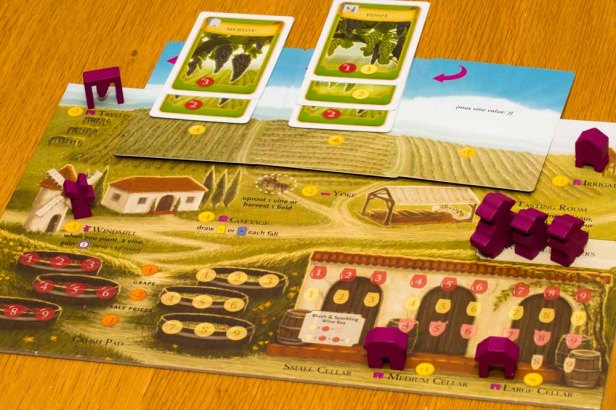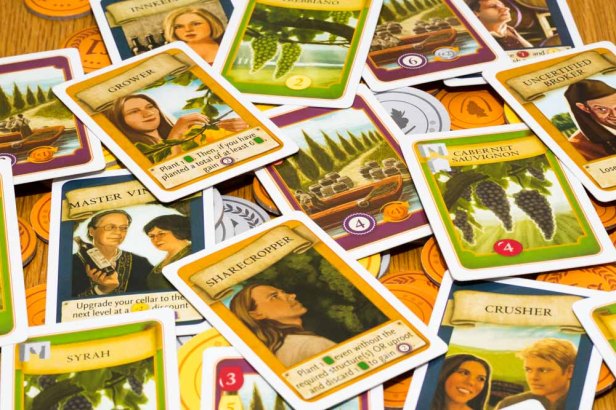Check out my d4 D.I.C.E. review and 10 minute teardown podcast for Viticulture
Player count: 1-6 players
Play time: 45-90 minutes
Designers: Jamey Stegmaier, Allan Stone & Morten Monrad Pedersen
Publisher: Stonemaier Games
Tuscany, visions of rolling hillsides, beautiful landscapes and of course vineyards.
In Viticulture, players take on the role of someone who has inherited a meagre vineyard in rustic, pre-modern Tuscany. You don’t start off with much, a few plots of land, an old crushpad, a tiny cellar and three workers. But you have a dream, a vision, of owning and running a successful winery.

Viticulture is a worker placement game that is played over a number of rounds. Each round players will allocate their workers across the seasons to perform various actions. Actions include gaining vine cards, planting vines, selling/buying land, constructing buildings, harvesting vines, making wine, fulfilling wine orders and playing visitor cards. But these spaces are limited as are your workers. Careful planning and balancing of worker placements in the summer and winter is essential. Victory points are scored mainly from fulfilling wine orders and the first person to score 20 points triggers the end of the game. The player with the most points is the winner.
Final Thoughts
Worker placement, a popular mechanism with The Friendly Boardgamer, so I was pre-disposed to liking Viticulture. Viticulture has been in my collection a while now, so what is it about the game that stands out? Is it the theme? Is it the mechanisms? Read on to find out more.
If I was to describe Viticulture in one word I would say “elegant”. The rules are relatively straight forward and the actions spaces are easy to understand and explain. Yet, the game can be super tight. For me Viticulture is my jam, it is my zen game. Despite it feeling, at times, super tight and tense, I find a level of peace and tranquility in the game.

The theme feels integrated strongly in to the mechanisms of the game. From the planting of the vines in the summer to harvesting vines and making wine. It invokes the feeling of running a vineyard. The visitor cards are varied and interesting and can really alter the way you play the game with some interesting actions/abilities and combinations. There is some randomness in what you draw from the card decks and you can be stuck with white grape vines and red wine order cards. But I have rarely found this to be a big issue. The end of round action of aging your wine gives the sense that your wine is gaining value, it is maturing, it is becoming a vintage.

Pulling off a big order always feels good. Especially if you do it form an unconventional route such as plying a visitor card. I like the addition of the “grande” meeple which allows you to go on a space that has already been taken. The game scales well for all player counts and works well at two and four. Six player game can run a bit long, but it still works well.

One of the biggest choices in the game is when to move to the next season. At the beginning of the game you only start off with three workers. There are action spots in summer and winter and you do not receive your workers back until the end of the round (i.e. after winter). That gives you three workers (initially) across both seasons. Use all your workers in summer and you will do nothing in winter. The tension of when to place your workers or when to pass is a big part of what makes Viticulture stand out for me.

There is also variable turn order. At the beginning of the round the active player places their cockerel on what is called the wake-up track. The position on the wake up track determines turn order. When placing your cockerel players receive a bonus which, objectively, gets better the lower down the track you go. Securing the position of being first player grants you no bonus. If you are not bothered about turn order and happy to go last then you can get an extra worker. I love this mechanism in games and it works very well here in Viticulture.
For me Viticulture is a game that is not going to be leaving my collection any time soon. It is simple in its design yet there are interesting choices to make. There is tension and competition for the worker placement spots, yet it feels relaxing and calming. There is variation in the summer and winter visitor cards. The game play flows like a chilled glass of chardonnay on a hot summers day and I keep coming back for another glass.



I’m a big fan of Viticulture, but have yet to add it to my collection. I think your write-up is spot-on — especially about the game being both tense & relaxing and the real sense of accomplishment from aging your wines. Thanks!
LikeLike
Thank you for the comment Steve. One game that I think will never leave my collection. Check out my visits from the Rhine Valley review (already published) and Moor visitors expansion coming soon.
LikeLike